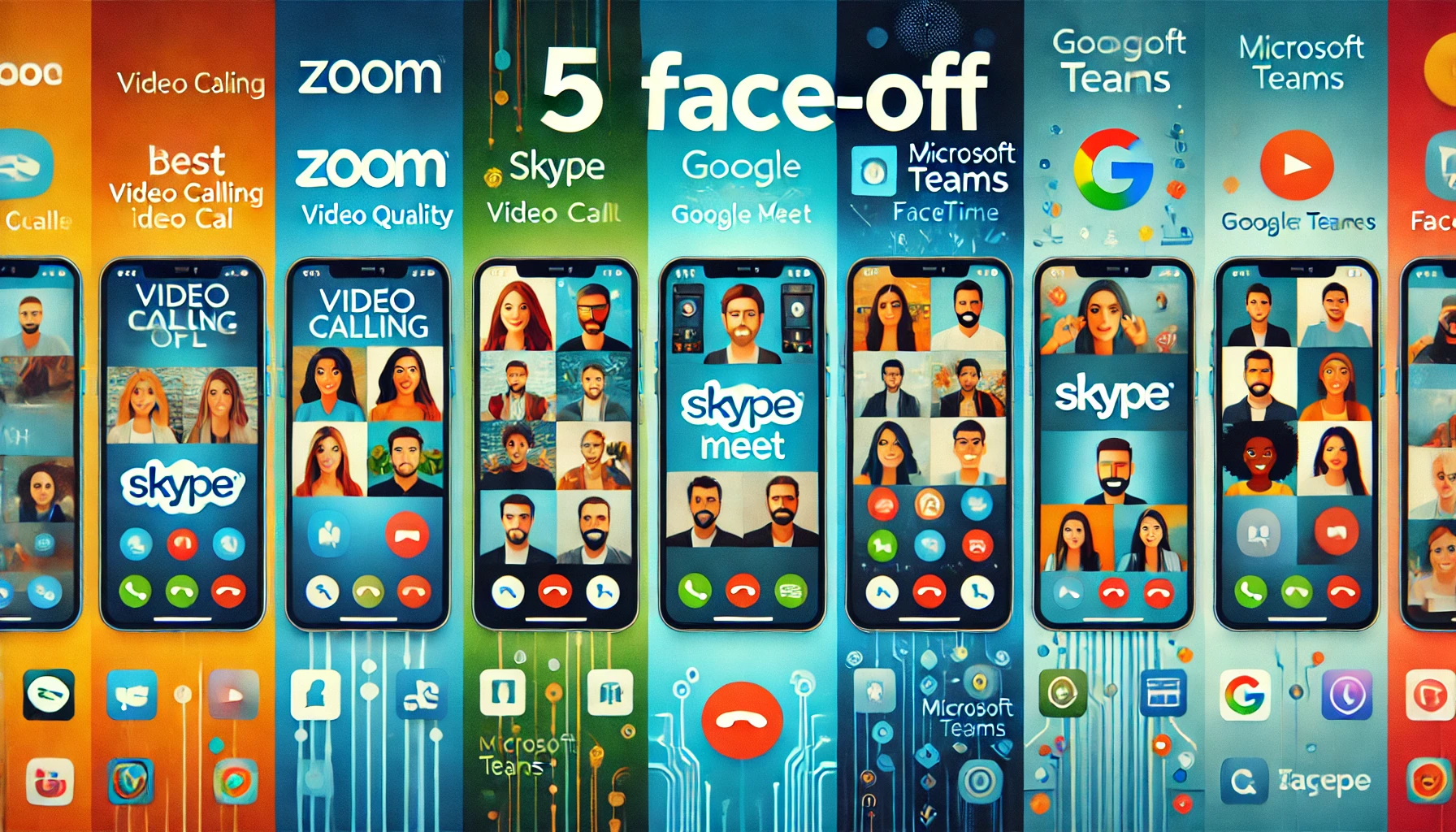Anúncios
In today’s hyper-connected world, having the right video calling app can make all the difference in both your personal and professional life.
With the rise of remote work, virtual family gatherings, and online learning, choosing the perfect video calling app to fit your needs is essential.
But with so many options available, which one stands out as the best?
This article will provide an in-depth comparison of the top 5 video calling apps, analyzing their strengths and weaknesses for various use cases, whether you need an app for casual conversations, professional meetings, or high-level security.
The Growing Importance Of Video Calling
In 2023, more than 80% of businesses and individuals have adopted video calling apps as their primary means of communication.
Whether it’s connecting with loved ones or conducting a global business meeting, having a reliable app is now a necessity.
Curiosity Trigger: Did you know that some video calling apps are designed for large meetings of up to 1,000 participants while others prioritize privacy with end-to-end encryption? Keep reading to find out which app best suits your needs.
Zoom: Best For Large Group Meetings
Strengths:
. Large Group Capabilities: Zoom is renowned for its ability to handle large meetings. It supports up to 100 participants on the free plan and up to 1,000 with the premium version.
Anúncios
. Breakout Rooms: Ideal for webinars or large group discussions, Zoom offers breakout rooms, allowing you to split your participants into smaller groups for focused conversations.
. High-Quality Video And Audio: Zoom excels in video and audio quality, even for large groups.
Weaknesses:
. Security Concerns: While Zoom has made improvements, it faced initial criticism for security flaws, which might concern those looking for airtight privacy.
. Time Limits On Free Plan: Free users are limited to 40-minute calls for group meetings.
Devices: Available on Android, iPhone, and desktop platforms.
Best For: Zoom is the go-to app for large group meetings, webinars, and corporate presentations.
2. Microsoft Teams: Best For Professional Collaboration
Strengths:
. Integration With Microsoft Office: Microsoft Teams is built for productivity.
Its integration with Office apps like Word, Excel, and PowerPoint makes it the perfect app for businesses that rely on Microsoft’s ecosystem.
. Large Meeting Capacity: Teams supports up to 300 participants in group calls on the free plan, with higher limits for paid users.
. Collaboration Tools: Features like file sharing, collaborative document editing, and team channels make Teams a robust option for work environments.
Weaknesses:
. Steep Learning Curve: Due to its broad feature set, Teams can be overwhelming for new users.
. Requires Microsoft Account: For full functionality, users must have a Microsoft account, which can be inconvenient for personal use.
Devices: Available on Android, iPhone, and desktop platforms.
Best For: Teams is ideal for professional environments, particularly if your organization uses Microsoft Office.
3. Google Meet: Best For Simplicity And Ease Of Use
Strengths:
. Browser-Based: Google Meet offers the convenience of not requiring a download. You can join meetings directly from your browser, making it incredibly simple and accessible.
. Google Integration: It integrates seamlessly with Google Calendar and Gmail, making scheduling meetings a breeze.
. Free For Up To 100 Participants: The free plan allows for meetings with up to 100 participants, which is great for personal and professional use.
Weaknesses:
. Limited Features: Google Meet lacks some of the advanced features found in apps like Zoom or Teams, such as breakout rooms or extensive collaboration tools.
. Time Limits: Free meetings are capped at 60 minutes, which might be restrictive for longer meetings.
Devices: Available on Android, iPhone, and web browsers.
Best For: Google Meet is perfect for those who want a simple, user-friendly video calling app without the hassle of installing additional software.
4. WhatsApp: Best For Casual Video Calls
Strengths:
. End-To-End Encryption: WhatsApp provides top-notch security with end-to-end encryption, ensuring your calls remain private.
. Global Reach: As one of the most popular messaging apps globally, WhatsApp makes it easy to connect with friends and family anywhere in the world, especially for free international video calls.
. Simple Interface: It’s user-friendly, making it accessible for all ages.
Weaknesses:
. Limited Participants: WhatsApp supports up to 8 participants in group video calls, which can be limiting for larger gatherings.
. Basic Features: It lacks the advanced features of other apps, such as screen sharing or file collaboration, making it less suitable for professional use.
Devices: Available on Android, iPhone, and desktops (via WhatsApp Web).
Best For: WhatsApp is ideal for casual, secure video calls with friends and family, especially for users seeking simplicity and privacy.
5. FaceTime: Best For Apple Users


Strengths:
. Seamless Integration With Apple Devices: FaceTime is pre-installed on all Apple devices, making it incredibly convenient for users within the Apple ecosystem.
. High-Quality Video And Audio: FaceTime offers excellent video and audio quality, ensuring smooth conversations even in group settings.
. Fun Features: The app includes interactive features such as Animoji and Memoji, which add a playful touch to video calls.
Weaknesses:
. Apple-Exclusive: FaceTime is only available for iOS and macOS devices, making it unusable for Android or Windows users.
. Limited Group Size: FaceTime allows group calls with up to 32 participants, which is smaller than apps like Zoom or Microsoft Teams.
Devices: Available on iPhone, iPad, and Mac.
Best For: FaceTime is the best choice for Apple users who want a seamless, high-quality video calling app.
Comparison Table: Top 5 Video Calling Apps At A Glance
| App | Strengths | Weaknesses | Best For | Maximum Participants |
|---|---|---|---|---|
| Zoom | High-quality video, breakout rooms | Security concerns, 40-minute limit on free plan | Large group meetings, webinars | 100 (Free), up to 1,000 (Paid) |
| Microsoft Teams | Office integration, file sharing | Steep learning curve, requires Microsoft account | Work meetings, team collaboration | 300 |
| Google Meet | Browser-based, simple interface | Lacks advanced features, 60-minute time limit | Personal use, simple work meetings | 100 |
| End-to-end encryption, global accessibility | Limited participants, basic features | Casual video calls with family and friends | 8 | |
| FaceTime | Seamless Apple integration, fun features | Only available for Apple devices | Apple users, personal calls | 32 |
This comparison table provides a clear overview of the top 5 video calling apps and helps you quickly assess which one suits your specific needs.
Tips For Choosing The Best Video Calling App For Your Needs
When selecting the best video calling app, consider the following factors:
. Purpose: Is the app for personal or professional use? Apps like Zoom and Microsoft Teams are designed for work, while WhatsApp and FaceTime are better for personal use.
. Group Size: How many participants will you typically have? For larger groups, Zoom or Teams is ideal, while WhatsApp or FaceTime works for smaller gatherings.
. Security: If privacy is a concern, choose apps like WhatsApp or FaceTime that offer end-to-end encryption.
. Platform: Make sure the app you choose works across devices. Google Meet, for example, is ideal for both Android and iPhone users, while FaceTime is limited to Apple devices.
FAQ: Common Questions About Video Calling Apps
Q: Which video calling app is best for large groups? A: Zoom and Microsoft Teams are great options for large group meetings, supporting hundreds of participants with robust features.
Q: Are video calling apps secure? A: Yes, apps like WhatsApp and FaceTime offer end-to-end encryption for secure calls. Zoom and Google Meet have also improved their security features over time.
Q: Can I use these apps for free? A: Yes! Most apps offer free plans with some limitations, like time caps or participant limits. Zoom, for instance, allows free group calls for up to 100 participants but limits sessions to 40 minutes.
Q: Which app is best for professional meetings? A: Microsoft Teams and Zoom are the top choices for professional use, thanks to their collaboration tools and high participant capacity.
Which Video Calling App Suits Your Needs Best?
In conclusion, the best video calling app depends on your needs—whether you prioritize security, group size, or integration with productivity tools.
For professional use, Microsoft Teams and Zoom are unbeatable.
If you’re looking for casual, secure calls with friends or family, WhatsApp or FaceTime will serve you well.
Ready to improve your video calling experience? Choose the app that fits your needs and start connecting with others effortlessly today!


